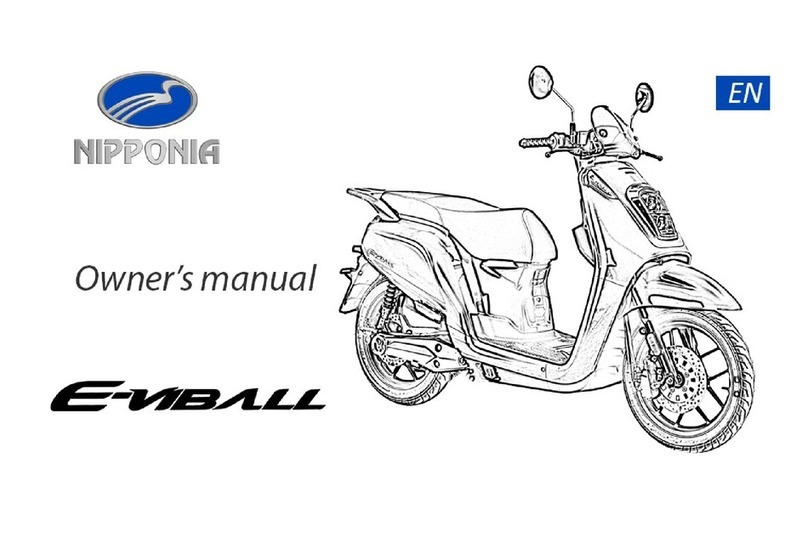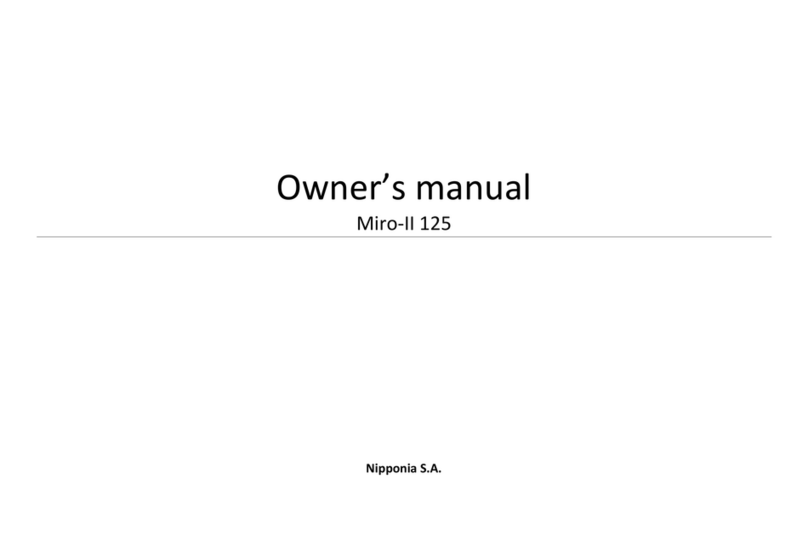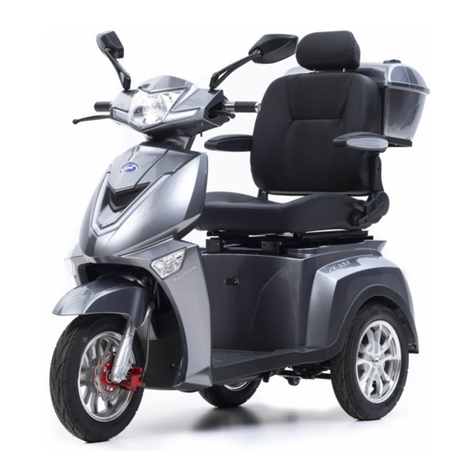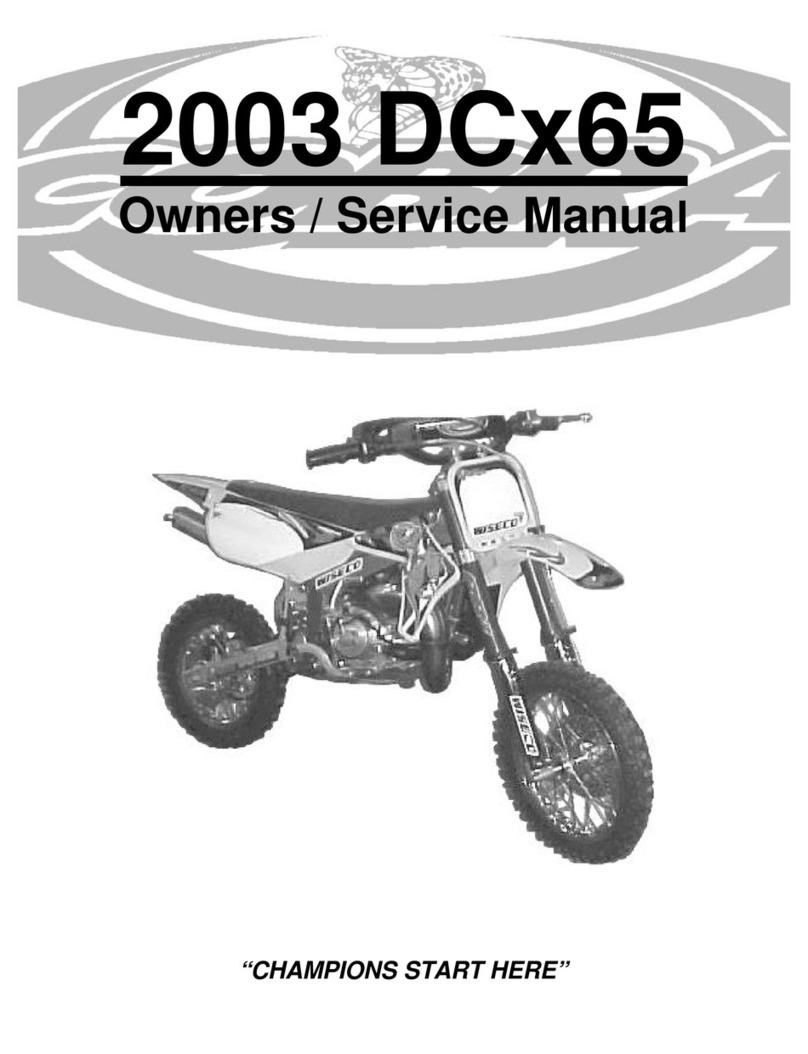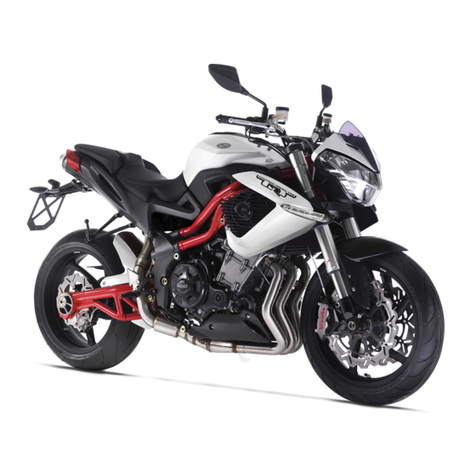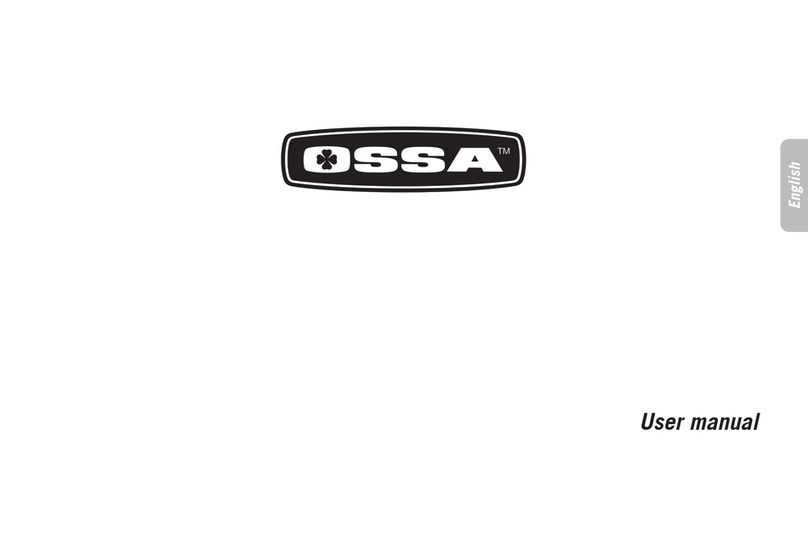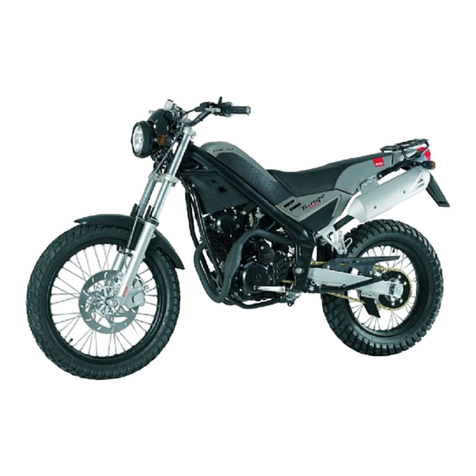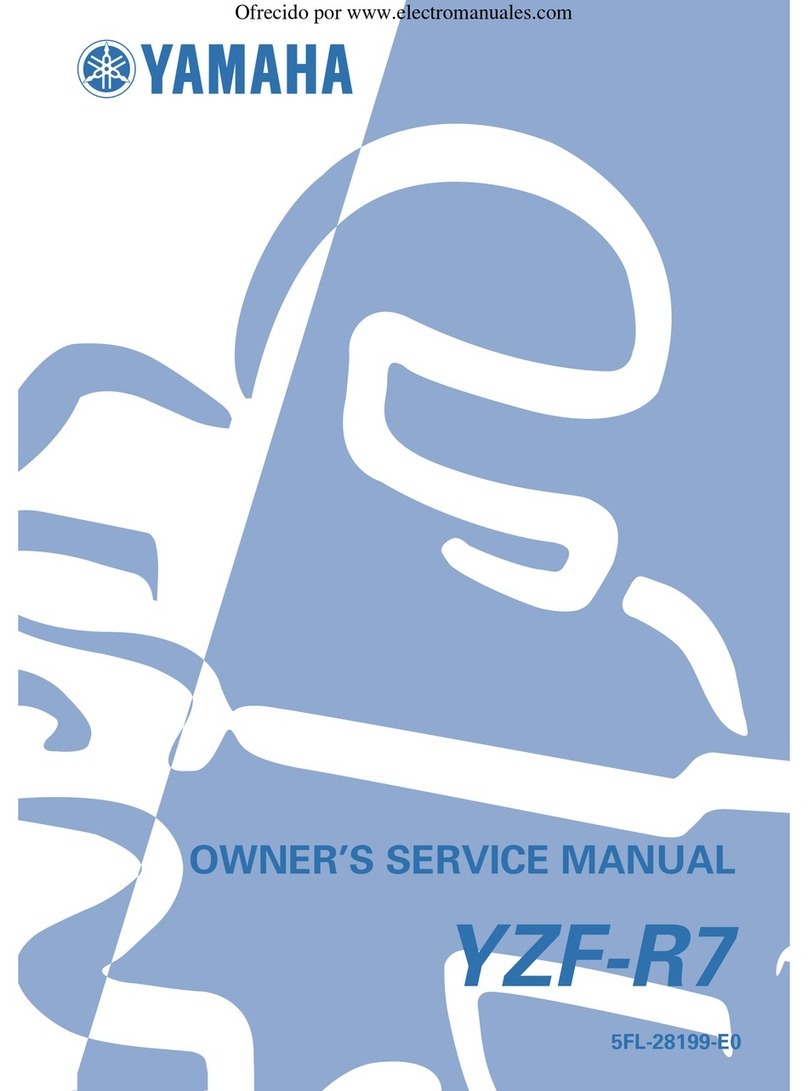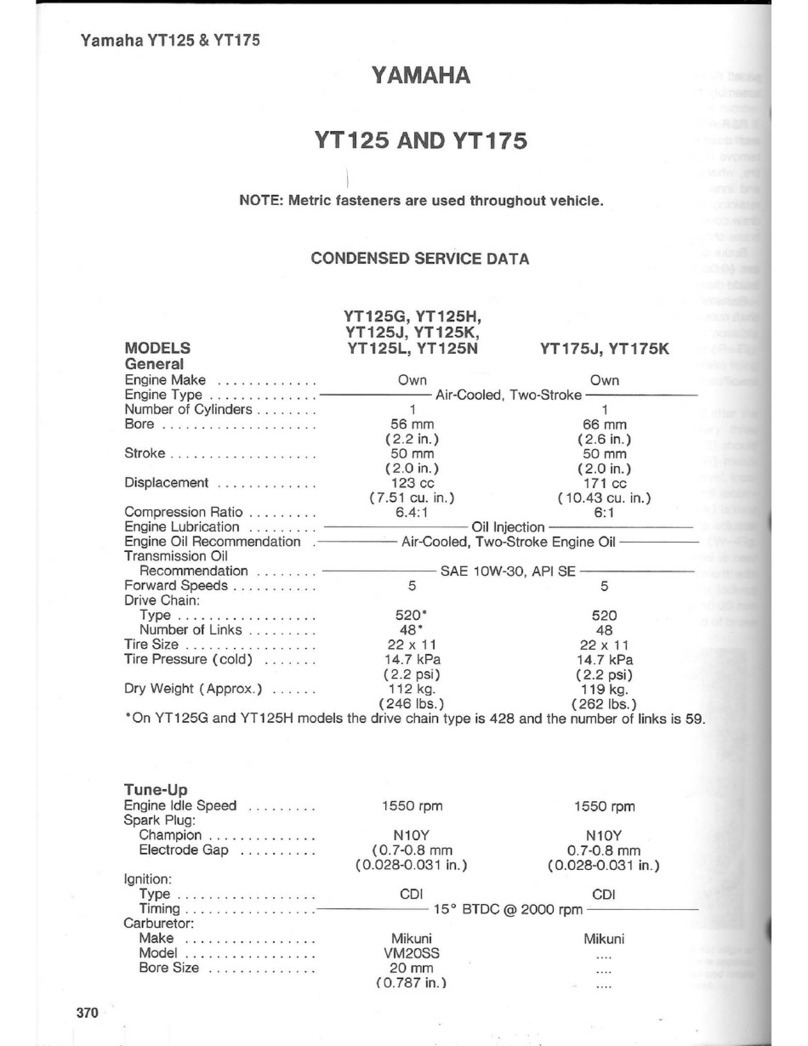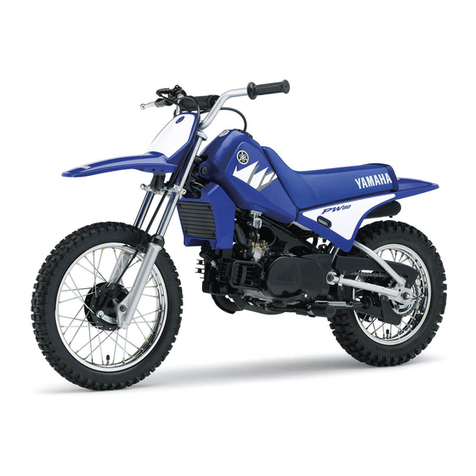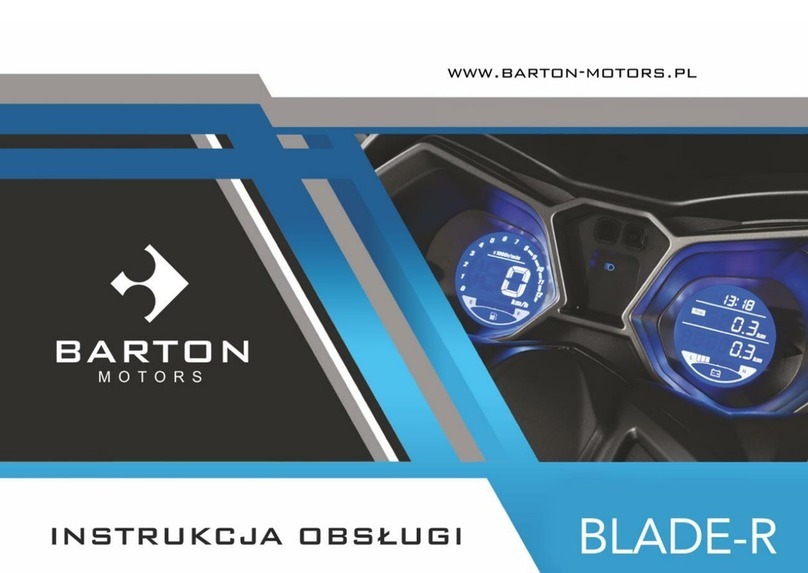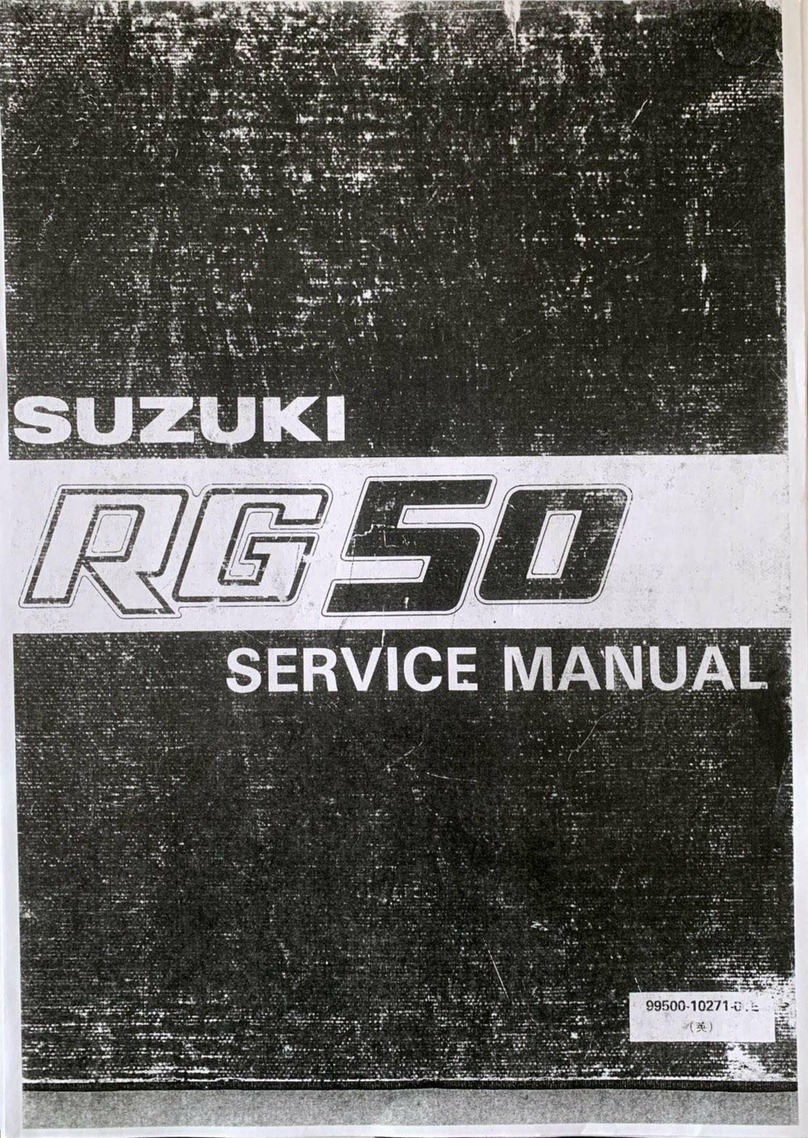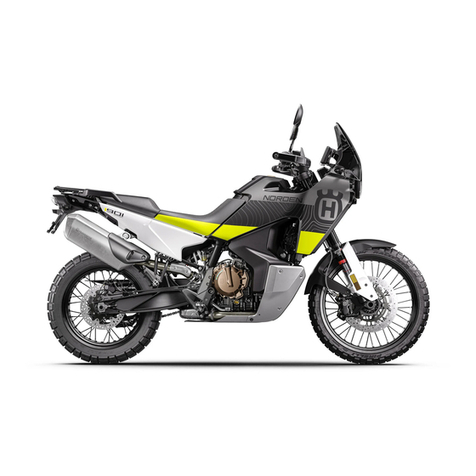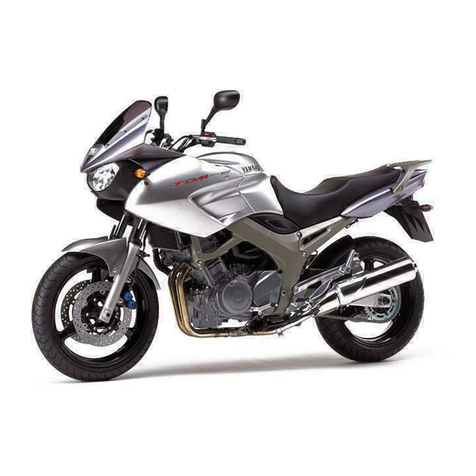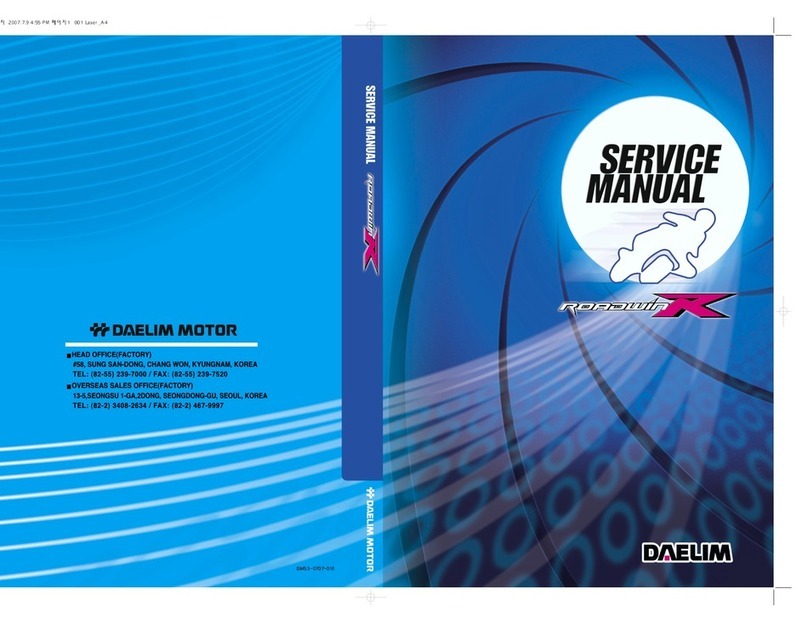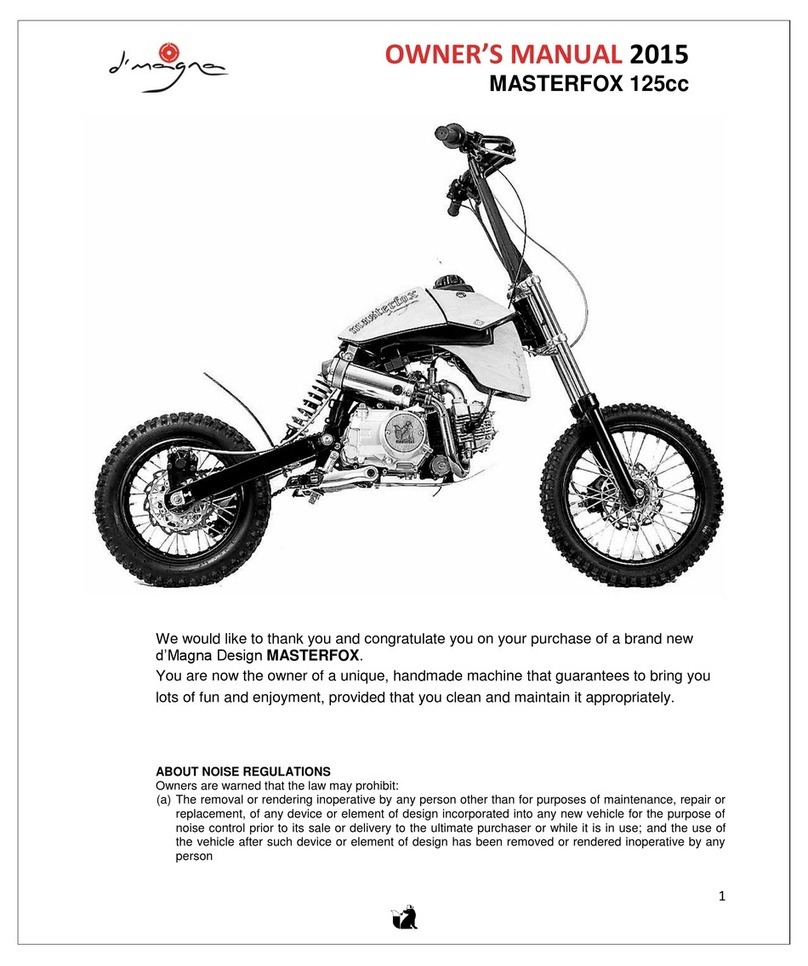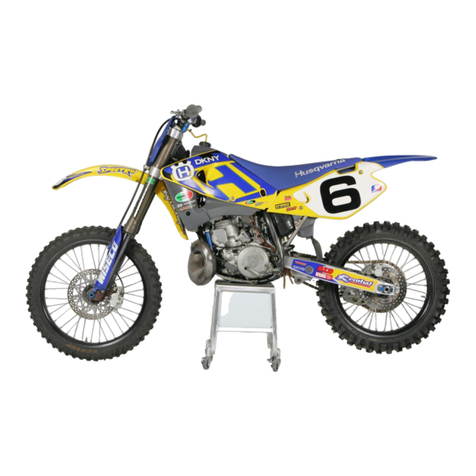Nipponia E-REX User manual



2
Table of Contents
1)
Safety........................................................................................................................02
2)
Specifications
...................................................................................................................09
3)
Overview of Motorcycle
................................................................................... 10
4)
Controls & Indicators
..............................................................................................
11
5)Operation..................................................................................................................
13
6
)
Maintenance & Maintenance Scheduling
............................................................
20
7)Troubleshooting
.......................................................................................................21
Saf
e
t
y
Before operating your new motorcycleit is your responsibility to read and follow the operating
and maintenance instructions in this manual, and to follow these basic rules for your personal
safety.
Before starting toride. check the battery strength,the brakes are working, that all lights are
functioning and both tires are correctly inflated.
Before stating to ride you must check all country, state and local lawsregarding the use of these
vehicles on public roadways. Where necessary, register and license you r motorcycle required by
law.
Ride safely, defensively and within the limits of the law. Ride with your headlamp on :
always wear a helmet,proper eye wear and protective clothing and insist that your passenger
does too. Never ride under the influence of alcohol and drugs.
Your motorcycle is designed for a maximum speed. It should be used on roads consistent
with travel at that speed and in accordance with posted speed limits, both minimum and
maximum.
CAUTION
CAUTION
! WARNING
! WARNING

4
3
As your motorcycle is an electric vehicle, it makes verylittle noise in operation. While driving your
motorcycle you must be aware that pedestrians and those in other vehicles may not hear you
approaching. Failureto sound your horn and drive defensively could result serious injury or even death.
Recharge your motorcycle in a ventilated environment. Do not recharge in a pace where there is
corrosive or flammable air.
Your motorcycle components are sealed to prevent moisture affecting the performance. When
cleaning your motorcycle, wash with care and do not saturate components with water.
When carrying passengers, itis your responsibility to instruct them on proper riding procedures.
We caution you against the use or non-standard parts or custom made parts, which may adversely
affect performance and handling. Removing or altering factory installed standard parts or altering the
original configuration of you motorcycle mayalso affect performance and could result serious injury or
even death.
Your motorcycle is equipped with a side kickstand and a center kickstand that bot h lock into position
when placed inthe full forward position and the motorcycle weight is rested on it .Without the
motorcycle weight resting on the stand or if the stand is not locked,the motorcycle may fall over.
Be sure both kickstands are fully retracted beforeridingthe motorcycle. If they are notfully retracted they
could come into contact with the road surface and cause a momentary disturbance before retracting. This
disturbance could result in loss of vehicle control and serious injury or even death.
Avoid excessive speed and never travel at a speed faster than the posted speed limit. To do so, could cause
loss of control resulting serious injuryor even death.
All listed services and maintenance recommendations shouId be performed. Lack of regular maintenance
at suggested intervals, may affect the safe operation of your motorcycle and could result serious injury or even
death.
Use of any non-standard or non-approved parts may void your warranty.
Do not tow an immobilized motorcycle with another vehicle at the same time. Steering and handling of the
disabled motorcycle will be affected by thetowline,causing loss of control and could result serious injury or
even death. Transport the immobilized motorcycle in a truck or a trailer.
! WARNING
! WARNING
! WARNING
! WARNING
! WARNING
! WARNING
! WARNING
! WARNING
! WARNING
CAUTION
CAUTION

5
6
Do not operateyour motorcycle with aloose, worn or damaged steering system, including front and
rear suspension system. Contact your dealer forrepairs. Failure to do so will adversely affect handling and
could result serious injury or even death.
Maintain proper tire pressure and ensure that the wheels and tires are correctly balanced. Inspect
your tires for tread wear and replacewith approvedtires only. Failure to do so can lead to improper
balance.
Do not pull a trailer behind a motorcycle. Towing a trailer may cause overload, unstable handling
and reduced braking efficiency that could result seriousinjury or even death.
Keep hazardous substances such as any fluid used in the operation and maintenance of your
motorcycle. Batteriesand cleaning compounds away from eyes, mouth or skin. These items must also
be kept out of children’s reach. Failure to do so could result serious injury or even death.
Consult your dealer regarding any questions or problems that occur duringthe operation ofyour motorcycle.
Failure to do so may aggravate the initial problem causing costly repairs and jeopardizing your safety.
The factory cannot test and make specific recommendations concerning every accessory or combination
of accessories sold. The rider must beresponsible for the same operation of the motorcycle when installing
accessories or carrying additional weight.
a.
Do not load weight or install accessories improperly on the motorcycle.
b.
Keep cargo weight concentrated close to the motorcycle and as possible to minimize changes to the
motorcycle's center of gravity.
c.
Distribute weight evenly on both sides of the motorcycle.
d.
Do not load bulky items too far behind the rider.
e.
Do not add weight or hand items on the handlebars or front forks.
f.
Luggage racks are designed for light weight items do not overload racks.
g.
Be sure cargo is secure and will not shift white riding. Check the cargo periodically.
Failure to follow these recommendations may affect the motorcycle’s stability, handling characteristics
and safe operating speed and could result serious injury or even death.
! WARNING
! WARNING
CAUTION
! WARNING
! WARNING
! WARNING

7
8
Front or rear guards may provide limited leg and cosmetic vehicle protection under unique circumstances such
as falling over whilst stopped. They are not made or intended to provide bodily protection injury in a collision with
another vehicle or object.
Pay strict attention toroad surfaces and wind conditions. These may include:
a.
Wind blasts from passing trucks.
b.
Holes in the pavement.
c.
Rough road surfaces.
Any two-wheeled vehicle may be subjectto theseforces influencing thehandling characteristics of the
vehicle. lf this happens, reduce speed and guide the motorcycle with a relaxed grip to a controlled condition. Do
not brake abruptly or force the handlebar. This may aggravate the unstable condition.
Do not allow othersunder any circumstances to operate your motorcycle unless you know they are
experienced, licensed riders and familiar with the operation of your particular motorcycle.
Protect your motorcycle from theft. After parking your motorcycle, lock the steering head and remove the
key from the ignition switch.
New riders should gain experience under various conditions while driving at various speeds. Operate your
motorcycle defensively. Remember, a motorcycle does not provide the same protection as an automobile in
an accident. One of the most common accident situations occurs when the driver of the other vehicle fails to
see or recognize a motorcycle and turns in tothe oncoming motorcyclist. Drive with your headlamp on.
Wear an approved helmet,clothingand foot gearsuitable for motorcycleriding. Brightor light coloursor
clothes with fluorescent patches or reflectors are best forgreater visibility intraffic, especially at night.
Accessories that change the operator’s riding position may increase reaction time and affect the handling
of the motorcycle.
Additional electrical equipment may cause overload of the motorcycle's electrical system and an
electrical system and/or component failure. Additional electrical load will also drain the batteriesfaster,
resulting in reduced travel distance and more frequent recharging.
! WARNING
CAUTION
CAUTION
CAUTION
CAUTION
CAUTION
CAUTION
CAUTION

9
10
Controls and Indicators
Overview of Motorcycle
1
NO
Description
Function
1
Master light power switch
Right/off all power to lights (except brake light) off
Center front safety/fog light plus rear taillight on Left
headlight on
2
Horn
Sounds horn
3
Throttle
Twist speed control
4
Brake levers
Front brake is same side as throttle control
5
Headlight high beam switch
Controls headlight high/low beam
6
Turn signal switch
Left/right turn signals
1.
Back mirror
2.
Seat cushion
3.
Taillight
4.
Fender
5.
Rear shock absorber
6.
Rear wheel
7.
Electric motor
8.
Headlight
9.
Turning light
10.
Front shock absorber
11.
Front wheel
12.
Front brake
NO
Description
1
High beam headlight indicator
2
Speedometer
3
Odometer
4
Direction light (turn signal)
5
Power indicator
6
Battery status indicator
10

11
12
Specifications
Your motorcycle is equipped with a steering lock. You can lock the steering head of the bike
by turningthe handlebarsto one side and turning the ignition key to the left lock position.
Removing the key will lock the steeringin the turned position.
Check that you have accomplished this by trying to turn the handlebar. Turning the key to the
right will unlock the steering head.
Turn the ignition key to the right position to start the bike.
Name
Specification
Name
Specification
Dimensions
1800x630x1120 mm
Electric motor nominal power
1500W
Wheelbase
1265 mm
Electric motor nominal current
13A
Weight (with 1 battery)
82 KG
Electric motor nominal voltage
60V
Load capacity
150 KG
Electric motor efficiency
>80%
GVWR
Battery type sealed acid gel
Polyelectrolyte
Max.speed
25 km/h –45 km/h
Charging voltage-input
220V
Range
55 km @ 45 km/h
Charging voltage-output
60V
Braking distance
7m (630 km/h)
Recharge energy consumption
1-1.8 KWh
Climbing ability
15°
Recharging time
6-8 h
Noise level
<55 dB(A)
Front headlamp
12V35W
Transmission
Infinitely variable speed
Direction indicator lamp
12V5W
Electric motor type
Brushless
Taillight
12V21W
Rechargeable battery
60V20Ah
Instrument panel lamp
12V1.7W
Tyre size
120/70-12

13
14
Operation
Pre-riding checklist
Read the controls & indicators sections of this manual before riding your motorcycle.
Before riding your motorcycle at any time, make ageneral inspection to be sure it is in a safe riding condition.
Check front andrear tire pressure and that the brakes are working.
Put upthe kickstand. Sit on the seat, put the key in the ignition switch and turn the key clockwise to on.
The power indicator lamp should be illuminated. Youcan now check the status of the battery charge level and
check that all lights including panel light, turning signal and stop lamp are working.
Starting the motorcycle
a.
Put up the kickstand.
b.
Sit on the seat, put the key in the ignition switch and turn the key clockwise to ON.
c.
Turn the twist throttle towards the rider. The motorcycle will start moving forward.
The rider must be sitting in a comfortable and balanced position when the motor bike is on before starting.
Failure to be correctly seated could result in being unseated asthe motorcycle movesforward and may result
serious injury or even death.
Changing speed
Turn the twist throttle inwards (counterclockwise) to accelerate the speed; turn the twist throttle
outwards (clockwise) to reduce speed.
Be sure the kickstand is fully retracted before riding the motorcycle. If it is not fully retracted it could come into
contact with the road surface and cause a momentary disturbance beforeretracting. This disturbance could
result in loss of vehicle control and result serious injury or even death.
Turn the throttle smoothly when changing speed, for your safety and to reduce any mechanical
damage.
! WARNING
! WARNING
CAUTION
CAUTION

13
14
Changing direction
a.
Switch the direction switch to the left or right before making a turn. The turn signal will flash.
b.
After turning, push the button once. The turn signal light turns OFF.
Braking
Braking is controlled by the brake hand leverslocated on either side of the handlebar. Applying either brake
lever will illuminatethe rear brake light.
Brakes should be applied uniformly and evenly toprevent from locking up. A balance between front andrear
braking is generally best.
Do not brake by using the front brake alone. This could ca use the motorcycle to tip forward unseating the
rider, and causing loss of controlof the motorcycle, which could result serious injury or even death.
Do not apply the brakes strongly enough to lock the wheels. Th is may cause loss of control ofthe
motorcycle and could result serious injury or even death.
NOTE: This motorcycle has a system which cuts off the motor power while braking. Return the throttle back
to normal position to avoid the motorcycle moving forward suddenly when you release the brake.
Points to remember while riding your scooter.
1.
Always sound your horn and use your turn signals when passing other vehicles going in the same
direction and never try to pass at intersections, round curves or when going up or down hill.
2.
Your electric motorcycle is a quiet machine, unlike normal motorcycles. Frequently use the horn to
warn other vehicles and pedestrians of you r presence.
3.
Al ways use your signals when preparing to pass or stop.
4.
Obey all traffic signs and signals. Be particularly careful when there are school or railroad crossing
signs.
5.
When turning, watch for pedestrians and animals as well as other traffic.
6.
Obey traffic lights. Don 't anticipate the light changing.
7.
Do not leave the curb or parking area without signaling and checking that your way is clear of
moving traffic.
8.
Be sure that your license plate(s) are correctly installed and visible, where applicable.
9.
Ride at a safe speed that is consistent with the type of road you are driving on. Watch for debris such
as leave or loose gravel, which can cause wheel slip.
10.
Adjust your driving to weather and traffic conditions, increase braking distance in wet, icy, oily road
conditions or when it is snowing.
CAUTION
! WARNING

15
16
Driving through water
The electric motor onyour scooter is located in the hub of the rear wheel. Avoid driving through
deep pudd les or still water that reaches up to the hub level of the wheel. Doing so willimmerse the electric
motor and could result in damage. lf you have driven through deep water, allow your motorcycle to
thoroughly dry out before using again and consult you r dealer.
Parking
Reduce the chance of theft or your motorcycle by using the steering lock.
Choose a safe parking space for yourmotorcycle.
Put down the kickstand.
Turn your handlebars to allow the steering lock to be activated.
Turn the ignition key to lock and pullout the key.
Recharging your motorcycle
Your motorcycle is equipped with a dual voltage charger which you may store in any of the three
storage areas provided on the bike, however it is recommended that you store the charger under the seat
where it can’t be inadvertently taken out of the storage compartment.
a.
Turn off the power.
b.
Lift the seat and pull out the charger, plug in one cord from the charger to the bike outlet located under
the seat and the other cord from the charger to an A/C outlet (your charger may be provided with a US
power plug so you may need an adapter, depending of the country you live). Then, you will be
charging the batteries on your bike. It will take about 6-8 hours.
c.
After charging, put the charger back to the box under the seat.
Notes:
1.
Always use the charger manufactured by our company only. Failure to do so will void all warranties.
2.
Charge the motorcycle under cover so that the water doesn’t enter the area under the seat while it is
lifted.
3.
Avoid using the fast charger (accessory) when possible to prolong the life of the batteries.
4.
The battery should be fully charged. Recharge the battery once a month even If it will not be used for a
while.
5.
If the temperature of the battery is too high or the indicator shows abnormal flashes, stop charging
and contact your authorized dealer.
6.
Recharge immediately aftereach ride to prolong battery life.
7.
If your motorcycle is stored and not used for a long time, charge your batteries before using it.
Recharge your motorcycle in a ventilated environment. Do not recharge in a space where there is
corrosive of flammable air.
! WARNING
! WARNING

19
20
Maintenance
Safety cut-off switch
Your motorcycle is provided with a cut-off switch located under the seat. This switch cuts off all power to
bike from the batteries and is used when transporting the bike.
You may also use the switch to:
1. Minimize the battery drain if you don’t intend to use your motorcycle for sometime.
2. As an addedtheft deterrent. You may turn the switch to the off position while parking your bike if you
expect to leave it parkedfor some time.
Storage
Your motorcycle is equipped with three locked areas for storage; under the seat, behind the seat and in
the front steering head.
Good maintenance means a safe motorcycle. A careful check over the motorcycle should be done
frequently between regular service intervals and after any time the motorcycle has been in storage or
unused for a period of time.
Before riding, always:
8.
Check the turn signals, horn, head lamp, taillight and brake lights.
9.
Check the function of the brakes and steering.
10.
Check the operation of the panel indicators.
At regular intervals check:
1.
The fasteners to make sure they are tightly connected.
2.
The electric connectors and make sure they are not loose.
3.
The front and back tires’pressure.
4.
Tires wear, tread depth, abrasions or cuts. lf they are worn replace the tires. Replace tires if the
depth of thread is less than 2mm.
5.
Brakes, steering and throttle for responsiveness.
6.
Any cables for fraying or crimping and for free operation.
7.
Wheel spoke tightness, if applicable.
If you find that any function bas seized up, recommends bringing your motorcycle to your
authorized dealer for overhaul.

21
22
Your motorcycles controller, charger, electric motor and circuit are finely adjusted and designed. If
you experience any troublewhich the electric components please consult your authorized dealer. Do not
unseal any component or attempt torepair yourself. Failure tofollow these directions will void all
warranties and may cause you a very expensive repair.
Troubleshooting
Warranty information
Thank you for choosing this electric motorcycle. Please keep your receipt and warranty card for the warranty to
be valid.
1. See the chart below for the warranty coverage
Item
Warranty
period
Depreciation rate
Malfunction
Electric motor
2 years
Rechargeable
Battery -3%
Others 1%
Malfunction
Rechargeable battery
2 years
Leakage or rated capacity <60%
Frame, front fork
2 years
Fail weld or broken
Controller
2 years
Malfunction
Charger
2 years
Malfunction
Note: Any
parts’ replacement (including motorcycle, charger and rechargeable battery) will be done under
the
warranty terms and within the warranty period.
Trouble
Cause
Repair
1
Turn on ignition, no
indication
Cut off switch in off position
Turn to on position
Loose battery wiring
Check wiring and tighten
2
Indicator lamps function
but the electric motor
does not start
Not sufficient battery charge
Recharge batteries
Accelerator throttle loose,
frayed or disconnected.
Take the bike
to an authorized workshop
Wiring problem in circuit or
charger malfunction.
Take the bike
to an authorized workshop
3
After charging, shortened
travel distance
Tires under-inflated
Pump up tires to correct pressure
Insufficient charging time
Recharge batteries
Charger trouble
Contact dealer
Battery age or deterioration
Change battery
! WARNING

!
2.
Warranty period begins according to the date on the receipt.
Please keep the receipt and warranty card.
3.
The warranty service doesn't apply to the following conditions:
a.
No receipt or warranty card.
b.
The recorded number is different.
c.
Improper repairs.
d.
Neglect of pro per maintenance.
e.
Abuse, overload or chemical damage.
f.
Appearance damage after selling.
g. Brake, fuse, light bulbs, wearable products.
4. If the rated capacity of the rechargeable battery is lower than 90 % within the 15 days of purchase,
we will replace with a new battery. If the rechargeable battery power is lower than 60 % within the
warranty period, we will repair it. But the warranty period is still based on the purchase date.
Thank you for choosing our product. Please keep the receipt and warranty card for free service within the warranty period.
Model#
Electric Motor#
Charger#
Battery#
Purchase date
Receipt#
Name
Zip code
Tel
Address
Dealer
Address
Table of contents
Other Nipponia Motorcycle manuals
